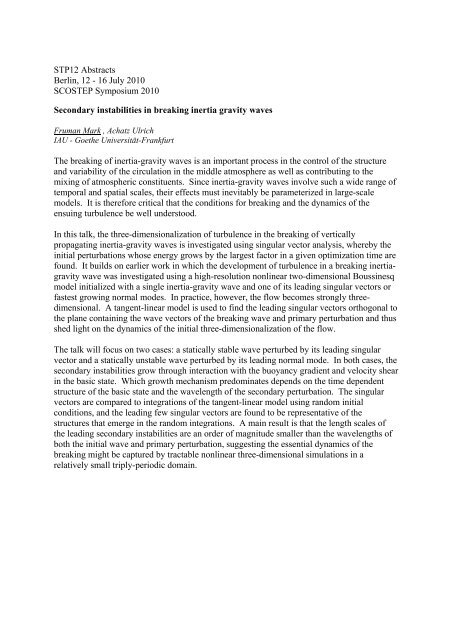scostep 2010 (stp12) - Leibniz-Institut für Atmosphärenphysik an der ...
scostep 2010 (stp12) - Leibniz-Institut für Atmosphärenphysik an der ...
scostep 2010 (stp12) - Leibniz-Institut für Atmosphärenphysik an der ...
Create successful ePaper yourself
Turn your PDF publications into a flip-book with our unique Google optimized e-Paper software.
STP12 Abstracts<br />
Berlin, 12 - 16 July <strong>2010</strong><br />
SCOSTEP Symposium <strong>2010</strong><br />
Secondary instabilities in breaking inertia gravity waves<br />
Frum<strong>an</strong> Mark , Achatz Ulrich<br />
IAU - Goethe Universität-Fr<strong>an</strong>kfurt<br />
The breaking of inertia-gravity waves is <strong>an</strong> import<strong>an</strong>t process in the control of the structure<br />
<strong>an</strong>d variability of the circulation in the middle atmosphere as well as contributing to the<br />
mixing of atmospheric constituents. Since inertia-gravity waves involve such a wide r<strong>an</strong>ge of<br />
temporal <strong>an</strong>d spatial scales, their effects must inevitably be parameterized in large-scale<br />
models. It is therefore critical that the conditions for breaking <strong>an</strong>d the dynamics of the<br />
ensuing turbulence be well un<strong>der</strong>stood.<br />
In this talk, the three-dimensionalization of turbulence in the breaking of vertically<br />
propagating inertia-gravity waves is investigated using singular vector <strong>an</strong>alysis, whereby the<br />
initial perturbations whose energy grows by the largest factor in a given optimization time are<br />
found. It builds on earlier work in which the development of turbulence in a breaking inertiagravity<br />
wave was investigated using a high-resolution nonlinear two-dimensional Boussinesq<br />
model initialized with a single inertia-gravity wave <strong>an</strong>d one of its leading singular vectors or<br />
fastest growing normal modes. In practice, however, the flow becomes strongly threedimensional.<br />
A t<strong>an</strong>gent-linear model is used to find the leading singular vectors orthogonal to<br />
the pl<strong>an</strong>e containing the wave vectors of the breaking wave <strong>an</strong>d primary perturbation <strong>an</strong>d thus<br />
shed light on the dynamics of the initial three-dimensionalization of the flow.<br />
The talk will focus on two cases: a statically stable wave perturbed by its leading singular<br />
vector <strong>an</strong>d a statically unstable wave perturbed by its leading normal mode. In both cases, the<br />
secondary instabilities grow through interaction with the buoy<strong>an</strong>cy gradient <strong>an</strong>d velocity shear<br />
in the basic state. Which growth mech<strong>an</strong>ism predominates depends on the time dependent<br />
structure of the basic state <strong>an</strong>d the wavelength of the secondary perturbation. The singular<br />
vectors are compared to integrations of the t<strong>an</strong>gent-linear model using r<strong>an</strong>dom initial<br />
conditions, <strong>an</strong>d the leading few singular vectors are found to be representative of the<br />
structures that emerge in the r<strong>an</strong>dom integrations. A main result is that the length scales of<br />
the leading secondary instabilities are <strong>an</strong> or<strong>der</strong> of magnitude smaller th<strong>an</strong> the wavelengths of<br />
both the initial wave <strong>an</strong>d primary perturbation, suggesting the essential dynamics of the<br />
breaking might be captured by tractable nonlinear three-dimensional simulations in a<br />
relatively small triply-periodic domain.











